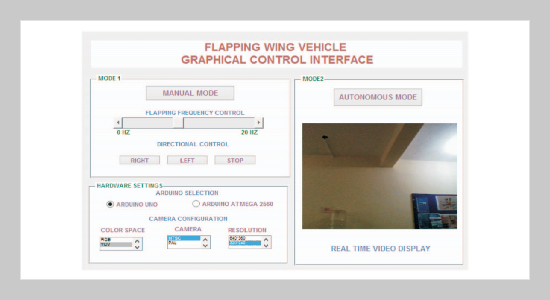REFERENCES
- [1] Deng, X., Schenato, L. and Sastry, S. S., “Flapping Flight for Biomimetic Robotic Insects: Part II-flight Control Design,” IEEE Transactions on Robotics, Vol. 22, No. 4, pp. 789803 (2006). doi: 10.1109/TRO. 2006.875483
- [2] Khan, Z. A. and Agrawal, S. K., “Design and Optimization of a Biologically Inspired Flapping Mechanism for Flapping Wing Micro Air Vehicles,” IEEE International Conference on Robotics and Automation, Rome, Italy, pp. 373378 (2007). doi: 10.1109/ROBOT.2007. 363815
- [3] Shigeoka, K. S., “Velocity and Altitude Control of an Ornithopter Micro Aerial Vehicle,” Master’s thesis, The University of Utah, USA (2007).
- [4] Yang, L. J., Balasubramanian, E., Chandrasekhar, U., Hung, K.-H. and Cheng, C.-M., “Practical Flapping Mechanisms for 20 cm-span Micro Air Vehicles,” International Journal of Micro Aerial Vehicle, Vol. 7, No. 2, pp. 181202 (2015). doi: 10.1260/1756-8293.7. 2.181
- [5] de Croon, G., de Clerq, K., Ruijsink, R., Remes, B. and de Wagter, C., “Design, Aerodynamics and Visionbased Control of the DelFly,” International Journal of Micro Air Vehicles, Vol. 1, No. 2, pp. 7197 (2009). doi: 10.1260/175682909789498288
- [6] Mak, L. C., Whitty, M. and Furukawa, T., “A Localisation System for an Indoor Rotary-wing MAV Using Blade Mounted LEDs,” Sensor Review, Vol. 28, No. 2, pp. 125131 (2008). doi: 10.1108/02602280810856688
- [7] Rudol, P., Wzorek, M., Conte, G. and Doherty, P., “Micro Unmanned Aerial Vehicle Visual Servoing for Cooperative Indoor Exploration,” Proceedings of the 2008 IEEE Aerospace Conference, Montana, USA, pp. 110 (2008). doi: 10.1109/AERO.2008.4526558
- [8] Kemp, C., Visual Control of a Quad-Rotor Helicopter, Ph.D. Dissertation, Churchill College, University of Cambridge, UK (2006).
- [9] Elik, K. C., Chung, S.-J. and Somani, A., “Mono-vision Corner SLAM for Indoor Navigation,” IEEE International Conference on Electro/Information Tech - nology 2008, Ames, IA, pp. 343348 (2008). doi: 10. 1109/EIT.2008.4554326
- [10] Ahrens, S., Vision-based Guidance and Control of a Hovering Vehicle in Unknown Environments, M.Sc. thesis, MIT, USA, June (2008). doi: 10.1109/ROBOT. 2009.5152680
- [11] Ruffier, F. and Franceschini, N., “Optic Flow Regulation: the Key to Aircraft Automatic Guidance,” Robotics and Autonomous Systems, Vol. 50, No. 4, pp. 177194 (2005). doi: 10.1016/j.robot.2004.09.016
- [12] Barrows, G., Neely, C. and Miller, K., “Optic Flow Sensors for MAV Navigation,” in Fixed and Flapping Wing Aerodynamics for Micro Air Vehicle Applications, Progress in Astronautics and Aeronautics, T. J. Mueller, Ed. AIAA, Vol. 195, pp. 557574 (2001). doi: 10.2514/5.9781600866654.0557.0574
- [13] Yu, Z.-Y., et al., “3D Vision Based Landing Control of a Small Scale Autonomous Helicopter,” International Journal of Advanced Robotic Systems, Vol. 4, No. 1, pp. 5156 (2007). doi: 10.5772/5710
- [14] Sinisa, T. and Nechyba, M. C., “A Vision System for Intelligent Mission Profiles of Micro Air Vehicles,” IEEE Transactions on Vehicular Technology, Vol. 53, No. 6, pp. 17131725 (2004). doi: 10.1109/TVT.2004. 834880
- [15] De Christophe, W., et al., “Autonomous Flight of a 20- gram Flapping Wing MAV with a 4-gram Onboard Stereo Vision System,” IEEE International Conference on Robotics and Automation (ICRA 2014), Hong-Kong, pp. 49824987 (2014). doi: 10.1109/ICRA.2014.6907 589
- [16] Moore, R. J. D., et al., “Autonomous MAV Guidance with a Lightweight Omnidirectional Vision Sensor,” IEEE International Conference on Robotics and Automation (ICRA 2014) Hong-Kong, pp. 38563861 (2014). doi: 10.1109/ICRA.2014.6907418
- [17] Shen, S., Nathan M. and Vijay K., “Autonomous Multifloor Indoor Navigation with a Computationally Constrained MAV,” IEEE International Conference on Robotics and Automation (ICRA 2011), Shanghai, pp. 2025 (2011). doi: 10.1109/ICRA.2011.5980357
- [18] Ruffier, F. and Franceschini, N., “Optic Flow Regulation: the Key to Aircraft Automatic Guidance,” Robotics and Autonomous Systems, Vol. 50, No. 4, pp. 177194 (2005). doi: 10.1016/j.robot.2004.09.016
- [19] de Croon, G., de Weerdt, E., de Wagter, C. and Remes, B., “The Appearance Variation Cue for Obstacle Avoidance,” IEEE International Conference on Robotics and Biomimetics (ROBIO), Tianjin, pp. 16061611 (2010). doi: 10.1109/ROBIO.2010.5723570
- [20] Baek, S. and Fearing, R., “Flight Forces and Altitude Regulation of 12 Gram I-Bird,” IEEE RAS and EMBS International Conference on Biomedical Robotics and Biomechatronics (BioRob), Tokyo, Japan, pp. 454460 (2010). doi: 10.1109/BIOROB.2010.5626347
- [21] Zufferey, J.-C., Klaptocz, A., Beyeler, A., Nicoud, J.- D. and Floreano, D., “A 10-gram Microflyer for Vision-based Indoor Navigation,” Proceedings of the 2006 IEEE/RSJ International Conference on Intelligent Robots and Systems, Beijing, China, pp. 3267 3272 (2006). doi: 10.1109/IROS.2006.282436
- [22] Zufferey, J.-C., Beyeler, A. and Floreano, D., Flying Insects and Robots, Edited by Dario Floreano, JeanChristophe Zuffery, Mandyam V. Srinavasan and Charlie Ellington, Springer, Chapter 6, Optic Flow to Steer and Avoid Collision in 3D, pp. 7386 (2009). doi: 10. 1007/978-3-540-89393-6_6
- [23] Hsiao, F. Y., Hsu, H. K., Chen, C. L., Yang, L. J. and Shen, J. F., “Using Stereo Vision to Acquire the Flight Information of Flapping-wing MAVs,” Journal of Applied Science and Engineering, Vol. 15, No. 3, pp. 213 226 (2012). doi: 10.6180/jase.2012.15.3.02
- [24] Nelson, D. R., et al., “Vector Field Path Following for Miniature Air Vehicles,” IEEE Transactions on Robotics, Vol. 23, No. 3, pp. 519529 (2007). doi: 10.1109/ TRO.2007.898976
- [25] Cooper, B., Chen, J. and Saxena, A., “Autonomous MAV Flight in Indoor Environments Using Single Image Perspective Cues,” IEEE International Conference on Robotics and automation (ICRA 2011), Shanghai, pp. 57765783 (2011). doi: 10.1109/ICRA.2011.5980136
- [26] Fairchild, M. D., Color Appearance Models, John Wiley & Sons (2013). doi: 10.1002/9781118653128. ch16
- [27] Sankarasrinivasan, S, Balasubramanian, E., Hsiao, F. Y. and Yang, L. J., “Robust Target Tracking Algorithm for MAV Navigation System,” IEEE International Conference on Industrial Instrumentation and Control (ICIC 2015), Pune, pp. 269274 (2015). doi: 10.1109/ IIC.2015.7150751
- [28] Cheng, H.-D., et al., “Color Image Segmentation: Advances and Prospects,” Pattern Recognition, Vol. 34, No. 12, pp. 22592281 (2001). doi: 10.1016/S0031- 3203(00)00149-7









